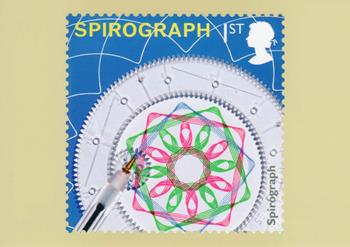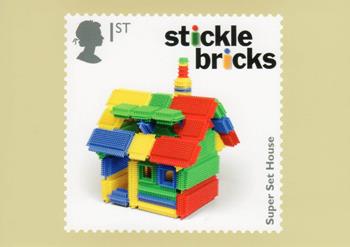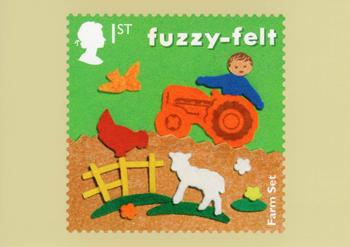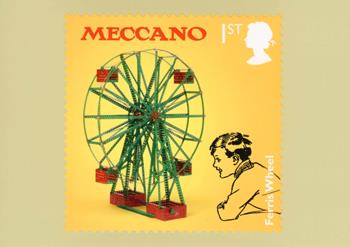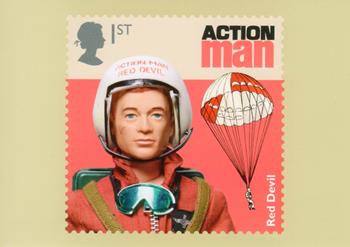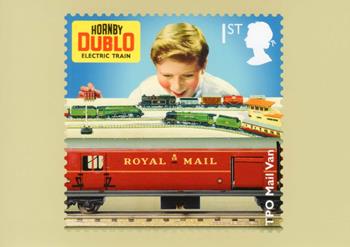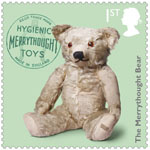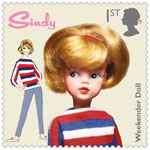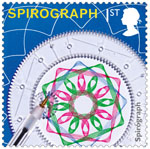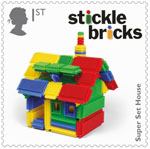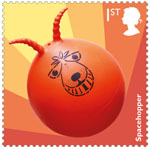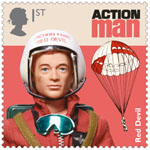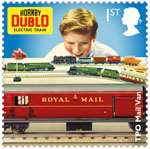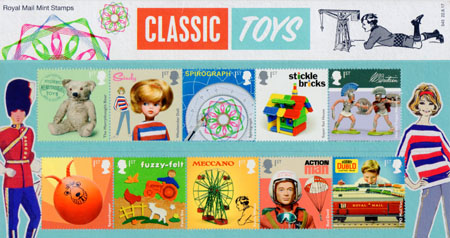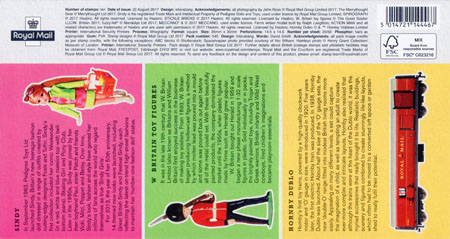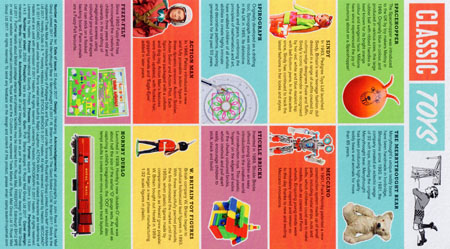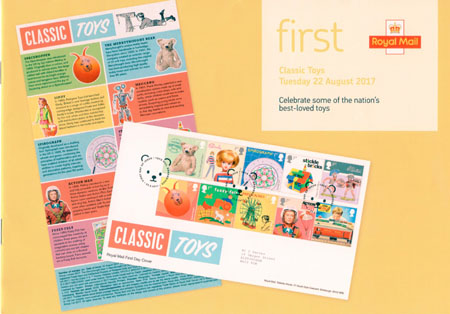Classic Toys
 Classic Toys at Royal Mail
Classic Toys at Royal Mail
The heyday of the British toy industry remains a magical era, one that shaped childhoods across the generations. And with many of the best-loved toys from the past still with us, or perhaps relaunched after temporary absences, the children of today can still have fun with some of the world’s most iconic toys.
2017 (August 22 2017)
Commemorative
Designed by Interbang
Size 35mm (h) x 37mm (v)
Printed by International Security Printers
Print Process Lithography
Gum PVA
Stamps
The Merrythought Bear
1stImage preview by Royal Mail
Merrythought’s quintessentially British teddy bears have been hand-crafted in Ironbridge, Shropshire since 1930. Founder of the company, Gordon Holmes, was the owner of a spinning mill in Yorkshire when he realised the possibilities of using mohair – the fleece of the Angora goat – in the production of soft toys. In 1931, the first catalogue revealed an eclectic range of 32 soft toys, including the original Merrythought teddy bear, whose patterns many of today’s designs are still based upon. The exceptional quality of Merrythought toys soon attracted high-end retailers such as Harrods. The company has continued to produce the finest soft toys in a variety of shapes and sizes for more than 85 years, appealing to children and adults of all ages.
Sindy
1stImage preview by Royal Mail
In September 1963, Pedigree Toys Ltd launched Sindy, Britain’s new teenage fashion doll dressed in a range of outfits created by cutting-edge designers Foale and Tuffin. Sindy’s first collection included her iconic Weekender (in a red, white and blue matelot top with bell-bottom jeans), as modelled on the stamp, as well as Skating Girl and Pony Club. Later in the 1960s, Sindy was joined by her then boyfriend Paul, sister Patch and friends Vicki, Mitzi, Poppet and Betsy. Over time, Sindy’s look, fashion and style have gained her millions of fans across the world who regard themselves as true ‘Sindy Girls’.
Stickle Bricks
1stImage preview by Royal Mail
Invented in the UK in 1969, Stickle Bricks offered an easy introduction to the world of construction toys. Designed to develop the imagination of young children, thanks to the appealing combination of chunky bricks in attractive bold colours, Stickle Bricks became a much-loved toy that encouraged children to stick, stack and build.
W.Britain Toy Figures
1stImage preview by Royal Mail
It was in the late 19th century that W. Britain Limited (also known as Britains and William Britain) first enjoyed success in the business of making toy soldiers. From 1893, W. Britain began producing hollowcast figures. The company dominated the market with these products until the 1950s, when plastic figures made by firms such as Herald grew popular.
Space Hopper
1stImage preview by Royal Mail
The precise origins of the ever-popular Spacehopper are uncertain, but what is known is that in the 1960s Aquilino Cosani patented a ‘Pon-Pon’ exercise ball that had many of the Spacehopper’s features. Marketed over the years under names such as the ‘Hoppity Hop’, the traditional Spacehopper was first introduced to the UK in 1969 by toy makers Mettoy. Originally blue in colour, and produced in a range of sizes, this large rubber ball with ribbed handles is best known for its bright orange colour and kangaroo face. Production rocketed in the 1970s as more and more children took to leaping about on a Spacehopper. For almost 50 years it has brought fun and happiness to millions of children, and currently has the status of a 21st-century retro toy.
Fuzzy Felt
1stImage preview by Royal Mail
For more than 65 years, Fuzzy-Felt has been encouraging the creativity of children three years old and upwards in the crafting of imaginative scenes using colourful pre-cut felt shapes that can stick on a flocked backing board. Perhaps less well known is the fact that the toy’s origins lie in the production of tanks during the Second World War. The tanks’ gaskets were made of felt and the manufacturing process created small offcuts which the factory workers’ children would play with. Lois Allan, whose outbuildings were used to make the gaskets during wartime, saw the potential for developing the idea, and launched the first Fuzzy-Felt set in 1950. The original felt pieces were plain silhouettes and later evolved into more detailed printed shapes on themes such as farm animals and dinosaurs.
Meccano
1stImage preview by Royal Mail
The idea for Frank Hornby’s unique construction system originated in 1898, when he was trying to source small parts for a model crane that he was making with his sons. He realised that it would be possible to make all sorts of models if children had immediate access to parts, such as metal strips and plates with holes in, which could be fitted together with nuts and bolts “in different positions and at different angles”. After the invention was patented in 1901, the first ‘Mechanics Made Easy’ sets were produced in 1902. Five years on, Hornby changed the product name to ‘Meccano’. Enquiring young minds worldwide were immediately inspired by Meccano and remain so to this day.
Action Man
1stImage preview by Royal Mail
Two years after the GI Joe toy arrived in the USA, in 1966 Palitoy introduced the youth of Britain to an exciting new toy called Action Man. This fully poseable action figure was originally produced in three different versions: Action Soldier, Action Sailor and Action Pilot. Each had painted hair (either black, brown, red or blond), a scarred face and came packaged with a basic uniform and dog tag.
Hornby Dublo
1stImage preview by Royal Mail
Hornby’s first toy trains, powered by a high-quality clockwork motor and ‘O’ gauge in size, were introduced in 1920. Five years later, the first electric Hornby train was produced. In 1938, Hornby Dublo was launched. About half the size of the ‘O’ gauge sets, the new ‘double-O’ range fitted into modest British living rooms more easily. Appealing on many different levels, a set could capture the imagination of a child, as well as tempting an adult to create ever-more complex and intricate layouts. Hornby also realised that although the trains were at the heart of the Dublo world, it was the myriad accessories that really brought it to life. Realistic buildings, scenery and figures combined to create stunningly life-like layouts, which often had to be moved to a converted loft space or garden shed to really fulfil their potential.
PHQ Cards


